
Nil volentibus arduum is a Latin expression meaning "nothing is impossible for those willing", and the name of a 17th-century Dutch literary society that tried to bring French literature to the Dutch Republic.

Nil volentibus arduum is a Latin expression meaning "nothing is impossible for those willing", and the name of a 17th-century Dutch literary society that tried to bring French literature to the Dutch Republic.

The Nil volentibus arduum literary society attempted to dictate the terms of the Dutch literary world and to exert intellectual influence by imposing the poetic rules of Aristotle, Horace, and Nicolas Boileau-Despréaux.
This society of francophiles [1] ardently defended French letters in the United Provinces, and as Jan Fransen: [2]
In 1669, in Amsterdam, a literary discussion on the subject of theatre led to the creation of a new artistic society, named Nil volentibus arduum. [3] Until then, the Amsterdam scene had been in the grip of glassmaker (vitrier) and writer Jan Vos (1610/1611-1667), who among other points expressed with the adage Het zien gaat voor het zeggen (« La vision précède la parole », (seeing precedes speaking)) the idea that visual elements were more expressive than words. [3] Vos was able to give himself over completely to his predilection for the visual thanks to his contacts in the Amsterdam government, who commissioned the stained-glass windows of the new Paleis op de Dam in 1655, as well as the large open-air living sculptures organized to greet important visitors. He also conceived ballets and theatrical productions, both his own and by other authors. His own works abounded in dramatical scenes. As regent of the Théâtre de Van Campen , Vos exercised considerable influence over its programming. To make special effects, like rapid changes of scenery and flying movements, possible—since the public adored such spectacles—he renovated the theatre in 1664–1665. But the popularity of Vos' work also rested on scenes of horror with elements like assassinations, hangings, dismemberment and other dark cruelties. Emotion and violence habitually constituted ingredients in his pieces: not because they rejoiced in such spectacles, but because his objective was to show the dangers of intemperance. [3]
Member of the society were Andries Pels (1631-1681), Pieter Cornelis Verhoek, Gérard de Lairesse, Lodewijk Meyer and Johannes Bouwmeester.

Everhardus Johannes Potgieter was a Dutch prose writer and poet, who was born at Zwolle in Overijssel.
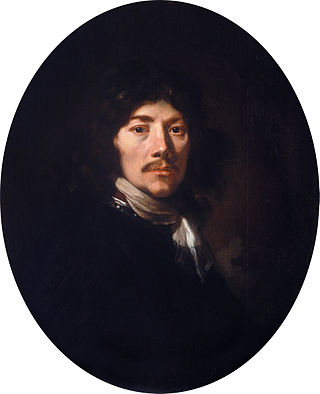
Jacob van Loo was a painter of the Dutch Golden Age, chiefly active in Amsterdam and, after 1660, in Paris. Van Loo is known for his conversational groupings; particularly his mythological and biblical scenes generally attributed to the genre of History painting. He was especially celebrated for the quality of his nudes to the extent that, during his lifetime, particularly his female figures were said to have been considered superior and more popular than those of his Amsterdam contemporary and competitor Rembrandt. In 1663, three years after fleeing to Paris, Jacob van Loo was accepted into the Académie royale de peinture et de sculpture.
Flemish literature is literature from Flanders, historically a region comprising parts of present-day Belgium, France and the Netherlands. Until the early 19th century, this literature was regarded as an integral part of Dutch literature. After Belgium became independent from the Netherlands in 1830, the term Flemish literature acquired a narrower meaning and refers to the Dutch-language literature produced in Belgium. It remains a part of Dutch-language literature.

Laurens Bake or Baak, Baeck was a Dutch poet of the seventeenth century.

Gerard or Gérard (de) Lairesse was a Dutch Golden Age painter and art theorist. His broad range of skills included music, poetry, and theatre. De Lairesse was influenced by the Perugian Cesare Ripa and French classicist painters such as Charles le Brun, Simon Vouet and authors such as Pierre Corneille and Jean Racine. His importance grew in the period following the death of Rembrandt. His treatises on painting and drawing, Grondlegginge Ter Teekenkonst (1701), based on geometry and Groot Schilderboek (1707), were highly influential on 18th-century painters.
The Arkprijs van het Vrije Woord is a symbolic award created in 1951 by Herman Teirlinck and the editorial team of the Nieuw Vlaams Tijdschrift to counteract ideologically driven restrictions on the freedom of expression.

Jan Jansz. Vos was a Dutch playwright and poet. A glassmaker by trade, he also played an important role as stage-manager and director of the theatre. He organized, on the mayors' orders, processions and splendid decorated floats, which sometimes drew disapproval, criticism, and derision.
Joan Leonardszoon Blasius was a Dutch poet, playwright, translator and lawyer. Born near Cadzand in Oostvliet, a village now lost to the North Sea, he was the younger brother of the famous doctor Gerard Blasius.

Levinus Vincent the Younger, was a rich Dutch designer of patterns and merchant of luxurious textiles, such as damask, silk and brocade.

Samuel Iperuszoon, Knight Wiselius was a successful Dutch lawyer and a prominent Patriot and democrat, involved in the dismantling of the Dutch East India Company (VOC) and the negotiations over the Cape. Wiselius was a witty, Voltairian spirit with political views far ahead of his time who would end his days writing dramas on Classical themes. Wiselius corresponded with nearly all the main players at the time of the Batavian Republic and it would be impossible to know that period completely without his carefully kept and neatly written correspondence. He was also a poet, historian and superintendent of the police.
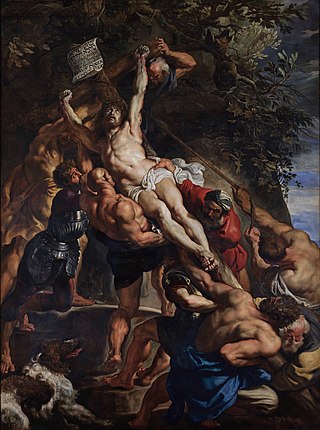
Flemish Baroque painting was a style of painting in the Southern Netherlands during Spanish control in the 16th and 17th centuries. The period roughly begins when the Dutch Republic was split from the Habsburg Spain regions to the south with the Spanish recapturing of Antwerp in 1585 and goes until about 1700, when Spanish Habsburg authority ended with the death of King Charles II. Antwerp, home to the prominent artists Peter Paul Rubens, Anthony van Dyck, and Jacob Jordaens, was the artistic nexus, while other notable cities include Brussels and Ghent.
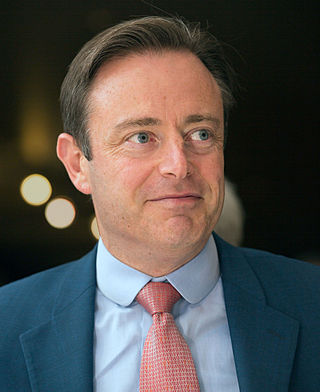
Bart Albert Liliane De Wever is a Belgian politician. Since 2004, De Wever has been the leader of the New Flemish Alliance (N-VA), a political party advocating for the transformation of Belgium into a confederal state. He is also a member of the Chamber of Representatives. De Wever presided over his party's victory in the 2010 federal elections when N-VA became the largest party in both Flanders and in Belgium as a whole. He accomplished this again in the subsequent 3 elections, eventually being tasked with forming a new government by King Philippe following the 2024 elections.

Katharyne Lescailje or Catharina Lescaille was a Dutch poet, translator and Publisher. Along with Catharina Questiers and Cornelia van der Veer she was the most successful female Dutch poet of the second half of the 17th century.

Jacobus Ludovicus Cornet, also known by his initials as J.L. Cornet, was a Dutch painter and draughtsman. He often depicted Dutch historic scenes and figures, contributing several paintings to Jacob de Vos Jacobszoon's gallery of oil paintings depicting scenes from Dutch history. Cornet also painted and drew portraits, landscapes, interiors and a range of other subjects.
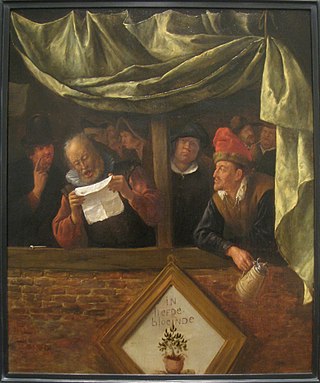
De Eglantier was a chamber of rhetoric in Amsterdam that arose in 1517 or 1518, possibly as a continuation of older chambers of rhetoric. It is one of the most famous chambers of rhetoric. Its insignia consisted of a thriving Eglantine Rose in the form of a cross from which a Christ Figure was hanging. The corresponding slogan was "In Love, Flourishing". The name derives from a romantic reference to the poem Beatrijs, where the lovers met by the wild rose. One of the most important leaders of the chamber was Hendrik Laurenszoon Spiegel. Other prominent members were Laurens Reael, Roemer Visscher and Dirck Volckertszoon Coornhert.
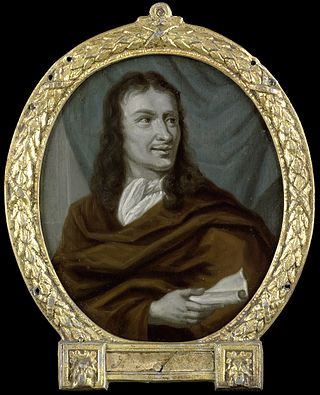
Pieter Verhoek, was a Dutch Golden Age poet and marble painter.
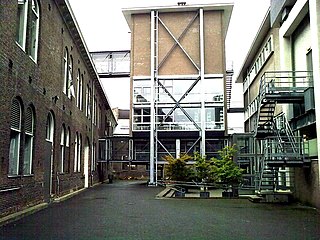
Koen Jozef van Velsen is an architect from Hilversum, Netherlands known for his design work on the Discothèque Slinger, rehabilitation center Groot Klimmendaal and the library in Zeewolde. His work employs a contextual design approach, free of a personal esthetic.
The Royal Academy of Science, Letters and Fine Arts of Belgium is the independent learned society of science and arts of the French Community of Belgium. One of Belgium's numerous academies, it is the French-speaking counterpart of the Royal Flemish Academy of Belgium for Science and the Arts. In 2001 both academies founded a joint association for the purpose of promoting science and arts on an international level: The Royal Academies for Science and the Arts of Belgium (RASAB). All three institutions are located in the same building, the Academy Palace in Brussels.
Jan Versweyveld is a Belgian theatre set designer, scenographer and lighting designer.
Johannes Bouwmeester was a Dutch physician, philosopher and a founding member of the literary society Nil volentibus arduum. He enrolled at Leiden University in 1651 and in 1658 graduated there in medicine. He was a close friend of Lodewijk Meyer, co-founder of Nil volentibus arduum, and acquainted with the philosophers Benedictus de Spinoza and Adriaen Koerbagh. His father, Claes Bouwmeester, was tailor by trade and several family members were builders of musical instruments. He was born in Amsterdam.
{{cite book}}: |work= ignored (help)